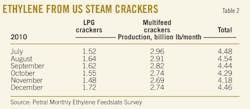Gary Farrar
Contributing Editor
Refinery fuels costs have endured an unsteady course since 2007.
As shown in the table above, most of the Petroleum Administration for Defense District (PADD) residual fuels' increases in cost occurred during 2007 and 2008 for all of the five districts.
PADD 4 experienced the least variance, while PADD 5 incurred the highest change in price over the period.
The cost for natural gas for refinery usage decreased a fair amount through 2007, increased in 2008, then decreased in 2009.
These conclusions are based on costs of an average refinery fuel consisting of 1 bbl each of PADDs 1-5 and an average US cost of 4.4 MMscf of natural gas (a 1 bbl equivalent on a btu content basis). Raw residual fuel oil and natural gas prices come from US Department of Labor publications. Biggest variations occurred in PADDs 1, 3, and 5. PADD 4 increased over the period in yearly average to 2,615.7 from 1,886.9.
PADD 1's 3-year averages started at 2,046.7, increased to 2,829.7, then decreased to 2,152.1.
All indexes shown are based on 1956 = 100, the basis of the Nelson-Farrar Operating Index for an average US refinery.




